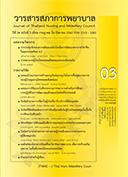The Effect of Motivation Program on Stroke Rehabilitation Motivation in Older Patients with Stroke
Keywords:
rehabilitation motivation program, rehabilitation motivation, older stroke patientsAbstract
Objective: To study the effects of a rehabilitation motivation program on older stroke patients.
Design: Two-group experimental research with one pre-test and two post-tests (in the frst and second weeks after the experiment).
Methodology: The sample was 44 older stroke patients selected based on the inclusion criteria from two tertiary hospitals. The patients were paired by age and then divided into a control group and an experimental group, so that both groups had as similar conditions as possible. The experimental group was given a two-week motivation-building programme in addition to standard care, whilst the control group received only standard care. Data were collected consecutively from the control group and then from the experimental group, using personal information interviews and a stroke rehabilitation motivation scale. The patients’ rehabilitation motivation was measured three times: before the experiment, one week after the experiment and two weeks after the experiment. The data were analysed using descriptive statistics, Chi Square, Mann-Whitney U Test, and Repeated Measure one-way ANOVA.
Results: A signifcant difference in rehabilitation motivation levels between the experimental group and the control group at week two after the experiment was evident (p < .05). Within the experimental group, the patients’ rehabilitation motivation levels differed signifcantly (p < .05) between before the experiment and one week after the experiment, whilst no signifcant difference was found between the frst-week and second-week post-experimental measures.
Recommendations: This programme had a positive impact on older stroke patients’ rehabilitation motivation. It is recommended that nurses apply it to older stroke patients in the process of rehabilitation.
Downloads
References
2. Department of Disease Control. Bureau of NonCommunicable Diseases. World Stroke Day 2016 [Internet]. 2016. [Cited 2017 March 25]. Available from: https://thaincd.com/2016/media-detail. php?id=12303&tid=&gid=1-015-001 (in Thai)
3. KitisomprayoonkulW.Strokerehabilitation.Bangkok: Danex Intercorperation; 2015. (in Thai)
4. Saksri W, Tananupabpaisal S. Rehabilitation in hemiparesis handbook. Bangkok: Amarin Printing & Publishing; 2009. (in Thai)
5. Verheyden G, Nieuwboer A, De Wit L, Thijs V, Dobbelaere J, Devos H, et al. Time course of trunk, arm,leg,andfunctionalrecoveryafterischemicstroke. Neurorehabil Neural Repair 2008;22(2): 173-9.
6. Van Dalen JW, Van Charante EPM, Nederkoorn PJ, Van Gool WA, Richard E. Poststroke apathy. Stroke
2008;44:851-60.
7. Thongcharoen W. Physical and physiological changes in elderly. In: Thongcharoen W, editor. Science and
art in gerontological nursing. 2nd ed. Bangkok: N P Press; 2015. p. 45-54. (in Thai)
8. Harris AL, Elder J, Schiff ND, Victor JD, Goldfne AM.Post-strokeapathyandhypersomnialeadtoworse
outcomes from acute rehabilitation. Transl Stroke Res 2014;5(2):292-300.
9. European Stroke Initiative Executive Committee. Europeanstrokeinitiativerecommendationsforstroke
management-update 2003. Cerebrovasc Dis 2003; 16:331-7.
10. Thailand Nursing and Midwifery Council. Nursing and midwife nursing act 2005 and edited by nursing and midwife act (issue 2) 1997. 2nd ed. Nonthaburi: Siriyod Printing; 2008. (in Thai)
11. Ryan RM, Deci EL. Self-determination theory and the facilitation of intrinsic motivation, social development, and well-being. Am Psychol 2000; 55(1):68-78.
12. BrainRehabilitationGroup.ThaiGeriatricDepression Scale. Siriraj Med J 1994;46(1):1-6. (in Thai)
13. Ministry of Public Health. Institute of Geriatric Medicine Ministry. Mini-Mental State Examination
Thail 2002. Nonthaburi: Ministry of Public Health; 1999. (in Thai)
14. Thompson S. Effect of the rehabilitation setting on motivation and clinical outcomes post stroke-a pilot study [dissertation]. New Zealand: University of Otago; 2012.42
15. Glass GV. Primary, secondary, and meta-analysis of research. Educ Researcher 1976;5:3-8.
16. Cohen J. Statistical power analysis for the behavior sciences. 2nd ed. New York: Lawrence Erlbaum Associates; 1988.
17. Adunwattanasiri P. The effectiveness of brain training program on attention and memory in acute ischemic
strokepatients[dissertation].NakhonPathom:Mahidol University; 2009. (in Thai)
18. White GN, Cordato DJ, Rourke FO, Mendis RL., GhiaD,ChanD.Validationofthestrokerehabilitation motivation scale: a pilot study. Asian J Gerontol Geriatr 2012;7(2):80-7.
19. Srisatidnarakul B. The methodology in nursing research. 5th ed. Bangkok: Chulalongkorn University;
2010. (in Thai)
20. Polit DF, Beck CT. Essential of nursing research: appraising evidence for nursing practice. 7th ed.
Philadelphia: Wolters Kluwer Health; 2010.
21. TeixeiraE,CarracaEV.,MarklandD,SilvaMN,Ryan, RM.Exercise,physicalactivity,andself-determination
theory: a systematic review. Int J Behav Nutr Phy 2012;9(78):1-30.
22. Fortier MS, Duda JL, Guerin E, Teixeira PJ, Pedro J. Promoting physical activity: development and testing
of self-determination theory-based interventions. Int J Behav Nutr Phy 2012;2:9-20.
23. Ryan RM, Williams GC, Patrick H, Deci EL. Selfdeterminationtheoryandphysicalactivity:thedynamics of motivation in development and wellness. Hell J Psychol 2009;6:107-24.
24. Jorgensen SW, Bice MR, Unruh S, Akehi K, Crockett H, Mcreynolds J. Motivation of shoulder surgery patients for rehabilitation. Int J Exerc Sci 2017;10(2):234-45.
25. Rahman RJ, Hudson J, Thøgersen-Ntoumani C, Doust JH. Motivational processes and well-being in
cardiac rehabilitation: a self-determination theory perspective.PsycholHealthMed2015;20(5):518-29.
26. Chang LP. Development of motivation to exercise in patients with parkinson‘s disease: an application
ofselfdeterminationtheory[dissertation].Philadelphia: Temple University; 2012.
27. Yu HF, Guo NW, Chen HY, Liang CP. Factors affecting stroke patients’ motivations for rehabilitation.
Kaohsiung J Med Sci 1993;9(5):305-16.
28. ShawKL.Patienteducation,motivation,compliance, and adherence to physical activity, exercise, and
rehabilitation. In: David MJ, James ZE, Quillen WS, Manske RC, editors. Pathology and intervention in
musculoskeletalrehabilitation.2nded.China:Elsevier;2016. p. 1-24.
29. Nicholson S, Sniehotta FF,Van Wijck FV, Greig CA, Johnston M, McMurdo MET. A systematic review
of perceived barriers and motivators to physical activityafterstroke.IntlJStroke2013;8(5):357-64.
30. Zielińska DA, Rajtar-Zembaty AM, Starowicz-Filip A. The influence of cognitive, emotional and social
factors on motivation for rehabilitation in patients after stroke. Neuropsychiatria i Neuropsychologia.
2015;10(2):64-8.
31. CarronAV,HausenblasHA,MackD.Socialinfluence and exercise: a meta-analysis. J Sport Exerc Psychol 1996;18:1-6.








